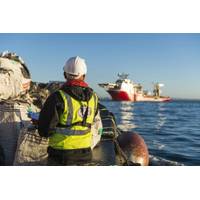Lankofirst Debuts Fiber Rope Connector for Deepwater Mooring
Lankhorst Ropes Offshore Division (LROD) announced the latest results of offshore trials of its Lankofirst synthetic fiber rope mooring connector on booth 1517 at OTC 2013. The trials have shown a significant reduction in mooring line deployment times and improvements in health and safety using the Lankofirst connector, compared with traditional mooring line plate links and thimbles.
The Lankhorst booth will also feature the ultra-low creep HMPE mooring rope made with Dyneema for permanent deepwater moorings beyond 2,000m water depth, and Lankhorst Mouldings' buoyancy modules for fiber rope mooring lines for the Goliat FPSO project.
Lankofirst fiber rope connector
Developed jointly by LROD worldwide agent, Offspring International, Lankhorst Ropes and subsea mooring connector specialist First Subsea, the Lankofirst fibre rope connector is designed specifically for deepwater fiber connections. According to Lankofirst, the ropes are smaller, lighter, stronger and more efficient than current plate links and thimbles, the Lankofirst is easier to make-up and the rope splice slimmer and lighter for the same MBL. The Lankofirst range includes rope-rope, rope-wire and rope-chain connectors.
Chris Johnson, sales director, Lankhorst Ropes said, “As offshore projects move to deeper waters the number of connectors per mooring line will increase, and so the ease of assembly and time saving benefits with Lankofirst will make a substantial impact of reducing mooring line installation times and thus deployment costs.”
Expansion in Rope Production Capacity
Lankhorst Ropes has increased rope production capacity at its new factory in Viana do Castello, Portugal, with the installation of a 12-strand braiding machine, Herzog SE 1/12-2000, for production of roundbraids from 20-200mm diameter.
The 12-strand machine will allow Lankhorst to offer a broader range of ropes, specifically larger Lanko force Ropes for use as slings in Heavy Lift applications. “It will enable a more flexible approach to the manufacture of deepwater mooring (DWM) ropes. Moving from eight-strand to 12-strand will reduce the number of sub-ropes per DWM while enabling higher sub-rope output, decreasing the time needed for splicing, and making the production process more efficient,” noted Chris Johnson.
www.lankhorstropes.com











